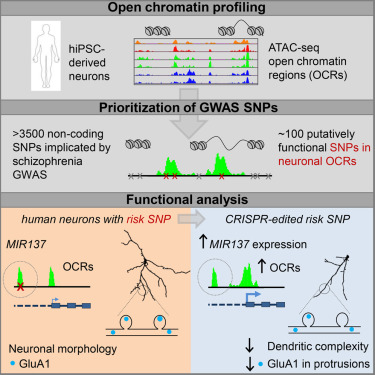当前位置:
X-MOL 学术
›
Cell Stem Cell
›
论文详情
Our official English website, www.x-mol.net, welcomes your
feedback! (Note: you will need to create a separate account there.)
Open Chromatin Profiling in hiPSC-Derived Neurons Prioritizes Functional Noncoding Psychiatric Risk Variants and Highlights Neurodevelopmental Loci.
Cell Stem Cell ( IF 19.8 ) Pub Date : 2017-09-07 , DOI: 10.1016/j.stem.2017.07.008 Marc P Forrest 1 , Hanwen Zhang 2 , Winton Moy 2 , Heather McGowan 3 , Catherine Leites 2 , Leonardo E Dionisio 1 , Zihui Xu 3 , Jianxin Shi 4 , Alan R Sanders 5 , William J Greenleaf 6 , Chad A Cowan 7 , Zhiping P Pang 3 , Pablo V Gejman 5 , Peter Penzes 1 , Jubao Duan 5
Cell Stem Cell ( IF 19.8 ) Pub Date : 2017-09-07 , DOI: 10.1016/j.stem.2017.07.008 Marc P Forrest 1 , Hanwen Zhang 2 , Winton Moy 2 , Heather McGowan 3 , Catherine Leites 2 , Leonardo E Dionisio 1 , Zihui Xu 3 , Jianxin Shi 4 , Alan R Sanders 5 , William J Greenleaf 6 , Chad A Cowan 7 , Zhiping P Pang 3 , Pablo V Gejman 5 , Peter Penzes 1 , Jubao Duan 5
Affiliation

|
Most disease variants lie within noncoding genomic regions, making their functional interpretation challenging. Because chromatin openness strongly influences transcriptional activity, we hypothesized that cell-type-specific open chromatin regions (OCRs) might highlight disease-relevant noncoding sequences. To investigate, we mapped global OCRs in neurons differentiating from hiPSCs, a cellular model for studying neurodevelopmental disorders such as schizophrenia (SZ). We found that the OCRs are highly dynamic and can stratify GWAS-implicated SZ risk variants. Of the more than 3,500 SZ-associated variants analyzed, we prioritized ∼100 putatively functional ones located in neuronal OCRs, including rs1198588, at a leading risk locus flanking MIR137. Excitatory neurons derived from hiPSCs with CRISPR/Cas9-edited rs1198588 or a rare proximally located SZ risk variant showed altered MIR137 expression, dendrite arborization, and synapse maturation. Our study shows that noncoding disease variants in OCRs can affect neurodevelopment, and that analysis of open chromatin regions can help prioritize functionally relevant noncoding variants identified by GWAS.
中文翻译:

hiPSC 衍生神经元中的开放染色质分析优先考虑功能性非编码精神病风险变异并突出神经发育位点。
大多数疾病变异位于非编码基因组区域内,这使得它们的功能解释具有挑战性。由于染色质开放性强烈影响转录活性,我们假设细胞类型特异性开放染色质区域(OCR)可能会突出与疾病相关的非编码序列。为了进行研究,我们绘制了从 hiPSC 分化的神经元中的全局 OCR,hiPSC 是一种用于研究精神分裂症 (SZ) 等神经发育障碍的细胞模型。我们发现 OCR 具有高度动态性,可以对 GWAS 相关的 SZ 风险变异进行分层。在分析的 3,500 多个 SZ 相关变异中,我们优先考虑了位于神经元 OCR 中的~100 个假定的功能变异,包括位于 MIR137 侧翼的主要风险位点的 rs1198588。来自带有 CRISPR/Cas9 编辑的 rs1198588 或罕见的近端 SZ 风险变异的 hiPSC 的兴奋性神经元显示出 MIR137 表达、树突分枝和突触成熟的改变。我们的研究表明,OCR 中的非编码疾病变异可以影响神经发育,并且开放染色质区域的分析可以帮助优先考虑 GWAS 识别的功能相关的非编码变异。
更新日期:2017-08-10
中文翻译:

hiPSC 衍生神经元中的开放染色质分析优先考虑功能性非编码精神病风险变异并突出神经发育位点。
大多数疾病变异位于非编码基因组区域内,这使得它们的功能解释具有挑战性。由于染色质开放性强烈影响转录活性,我们假设细胞类型特异性开放染色质区域(OCR)可能会突出与疾病相关的非编码序列。为了进行研究,我们绘制了从 hiPSC 分化的神经元中的全局 OCR,hiPSC 是一种用于研究精神分裂症 (SZ) 等神经发育障碍的细胞模型。我们发现 OCR 具有高度动态性,可以对 GWAS 相关的 SZ 风险变异进行分层。在分析的 3,500 多个 SZ 相关变异中,我们优先考虑了位于神经元 OCR 中的~100 个假定的功能变异,包括位于 MIR137 侧翼的主要风险位点的 rs1198588。来自带有 CRISPR/Cas9 编辑的 rs1198588 或罕见的近端 SZ 风险变异的 hiPSC 的兴奋性神经元显示出 MIR137 表达、树突分枝和突触成熟的改变。我们的研究表明,OCR 中的非编码疾病变异可以影响神经发育,并且开放染色质区域的分析可以帮助优先考虑 GWAS 识别的功能相关的非编码变异。











































 京公网安备 11010802027423号
京公网安备 11010802027423号